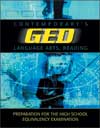|
 |  Contemporary's GED Language Arts, Reading John M. Reier
Nonfiction Prose
Chapter OutlineStudy the chapter outline below. Use the page numbers below each topic to refer to the corresponding section in Contemporary's GED Language Arts, Reading. When you are finished, go to the Flashcards or choose a different activity or chapter from the menu on the left.
Nonfiction Prose
(See 109)
Nonfiction prose consists of written works that deal with real people, places, events, and social issues. |
 |  |  | Reading to Understand Nonfiction
(See pages 109–117)
The following reasoning skills are important in reading and interpreting nonfiction prose: - Comprehension: understanding the literal meaning
- Application: applying information and ideas from a passage
- Analysis: analyzing content, style, and structure
- Synthesis: making connections between separate sources of information
There are three main types of nonfiction prose:
- Informative essays educate the reader about a selected subject.
- Critical essays present an in-depth analysis of a subject.
- Reviews briefly describe the content of a work of art and evaluate its strengths and weaknesses.
Recognizing the difference between facts and opinions enhances your understanding of nonfiction prose:
- Fact—a statement that can be proved
- Opinion—a statement that reflects a writer’s personal views
Recognizing descriptive language enables you to determine a writer’s views on his or her subject.
Suggestions for reading commentaries:
- Find the main idea of the passage.
- Look for facts or examples used to support the author’s point of view.
- Pay close attention to descriptive language.
- Notice characteristics of style and structure.
- Draw your own conclusions from the information presented in the passage.
|
|
|



 2002 McGraw-Hill Higher Education
2002 McGraw-Hill Higher Education